Discover everything about Digital ROI learn how to measure, improve, and maximize ROI in digital marketing to boost your online profitability.
Introduction
In the modern business world, every click, impression, and conversion matters. Brands are investing heavily in digital marketing but spending money is not the same as earning results. That’s where Digital ROI (Return on Investment) comes in. It helps businesses understand whether their digital marketing efforts SEO, PPC, social media, email, or content—are actually delivering measurable value.
Whether you’re running an e-commerce store, a startup, or a large-scale company, tracking your ROI in digital marketing is the key to sustainable growth. It’s not enough to have ads running or posts going viral; what truly matters is how much profit your campaigns generate compared to how much you spend.
Understanding digital marketing ROI helps marketers and business owners make data-driven decisions, refine strategies, and ensure every rupee or dollar spent online delivers the best possible return. In this detailed guide, you’ll learn what is ROI in digital marketing, how to measure digital ROI, and how to improve your return on investment digital marketing performance with real examples and actionable insights.
What Is ROI in Digital Marketing?
ROI in digital marketing stands for Return on Investment. It measures the profitability of your online marketing activities. Simply put, it shows whether your marketing digital ROI is positive (profitable) or negative (loss-making).
It answers questions like:
- Are my paid ads generating enough revenue?
- Is my SEO investment actually increasing sales?
- Which online marketing channel provides the best ROI digital results?
The general formula for calculating ROI digital marketing is:
ROI=(Revenue−MarketingCost)MarketingCost×100ROI = \frac{(Revenue – Marketing Cost)}{Marketing Cost} \times 100ROI=MarketingCost(Revenue−MarketingCost)×100
Example:
If you spend ₹1,00,000 on digital ads and generate ₹4,00,000 in revenue, your return on investment digital marketing is:
(400000−100000)/100000×100=300%(400000 – 100000) / 100000 \times 100 = 300\%(400000−100000)/100000×100=300%
That means you earn ₹3 for every ₹1 spent a strong digital ROI.
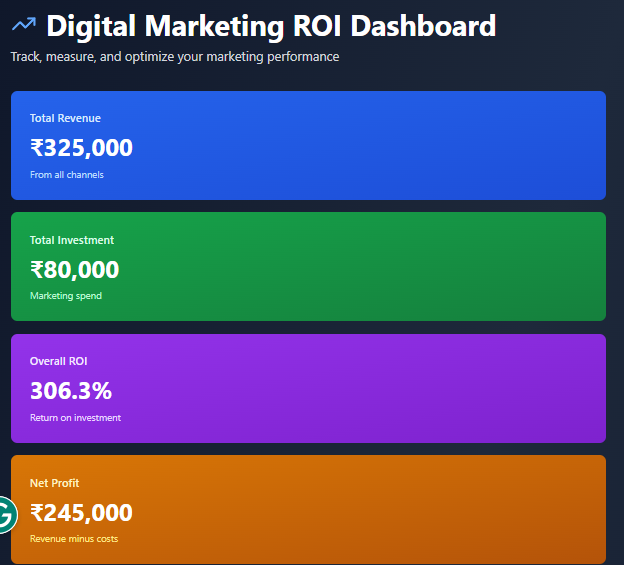
Why Is Measuring Digital ROI Important?
Tracking digital marketing ROI gives you a clear picture of how your campaigns perform. Without it, you’re flying blind spending money without knowing if it’s paying off.
Here’s why ROI in digital marketing matters:
- Informed Decision-Making: You can identify which strategies (SEO, PPC, or social) bring the best digital return on investment.
- Budget Optimization: Allocate funds to the most profitable marketing channels.
- Campaign Improvement: Identify weak spots and improve targeting for higher ROI on digital marketing.
- Performance Tracking: Evaluate whether your marketing is generating consistent long-term results.
For instance, if your digital advertising ROI from Google Ads is 200%, but only 70% from Facebook, it’s smarter to shift budget toward Google.
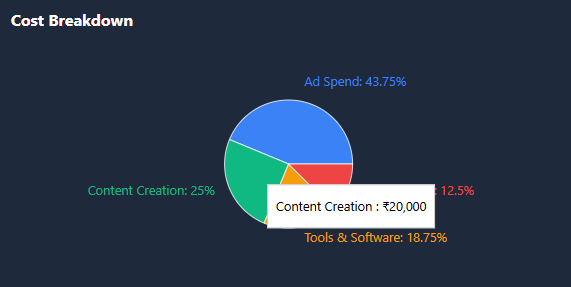
How to Measure ROI in Digital Marketing
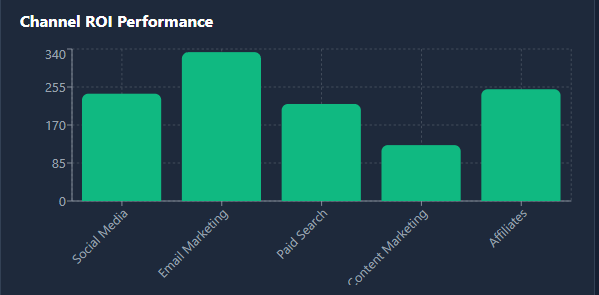
Calculating marketing digital ROI involves combining financial and performance data from multiple sources. Here’s a step-by-step method:
1. Define Clear Goals
Determine what success looks like—sales, leads, downloads, or brand engagement. Your ROI of digital marketing will differ depending on your goal.
2. Identify All Costs
Include ad spend, content creation costs, tool subscriptions, and staff salaries. This gives a true picture of your ROI on digital marketing.
3. Track Conversions Accurately
Use tools like Google Analytics, Meta Ads Manager, or HubSpot to track conversions and calculate digital marketing return on investment correctly.
4. Use Attribution Models
Multi-channel attribution models help identify which touchpoints contribute most to your online marketing ROI.
Example:
- Total Marketing Cost = ₹80,000
- Revenue Generated = ₹2,00,000
- ROI = (2,00,000 – 80,000) / 80,000 × 100 = 150%
That’s a profitable ROI for digital marketing campaign.
How to Improve ROI in Digital Marketing
Boosting your return on investment digital marketing isn’t just about cutting costs—it’s about being smarter with your strategy. Try these proven methods:
1. Optimize Campaigns Regularly
Continuously test and refine ad copies, landing pages, and CTAs to improve digital ROI performance.
2. Focus on High-Value Channels
Analyze which platforms yield the best ROI digital marketing and prioritize those.
3. Enhance Your Website Conversion Rate
Even small UX improvements can significantly raise marketing digital ROI.
4. Use Automation and AI Tools
Automate repetitive tasks like email follow-ups and social posting to save time and improve ROI internet marketing efficiency.
5. Track Metrics That Matter
Look beyond clicks—focus on cost per lead (CPL), customer lifetime value (CLV), and overall digital marketing ROI.
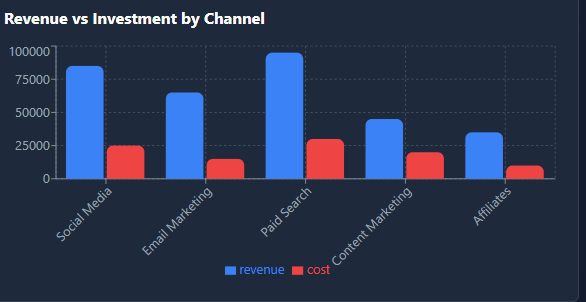
Examples of ROI in Digital Marketing
Example 1: SEO Campaign
A travel website invests ₹60,000/month in SEO and earns ₹2,10,000 in organic leads and bookings.
ROI = (2,10,000 – 60,000) / 60,000 = 250%
Example 2: Paid Advertising
A company spends ₹50,000 on Facebook Ads and generates ₹1,50,000 in sales.
ROI = (1,50,000 – 50,000) / 50,000 = 200%
Both examples show how digital advertising ROI helps businesses identify the most profitable marketing methods.
Benefits of Tracking ROI in Digital Marketing
- Better digital return on investment planning
- Optimized marketing digital ROI strategies
- Increased accountability in marketing teams
- More precise targeting and segmentation
- Improved long-term profitability
When businesses focus on improving ROI for digital marketing, they make smarter decisions and achieve measurable growth.
Common Challenges in Measuring ROI Digital
- Difficulty in tracking multi-channel conversions
- Incomplete or inaccurate data reporting
- Misalignment between marketing and sales goals
- Overreliance on vanity metrics instead of actual ROI on digital marketing
To overcome these challenges, use consistent tracking methods and integrate CRM tools to measure your ROI of digital marketing accurately.
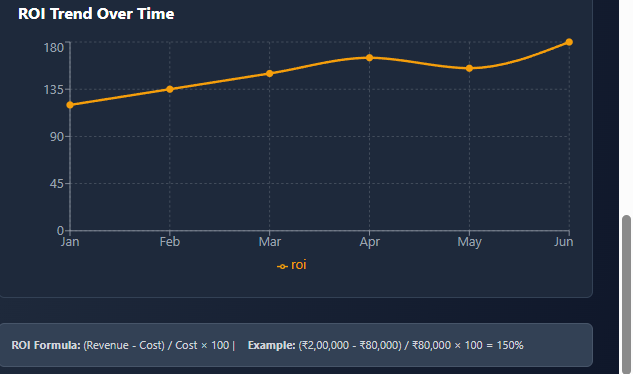
Conclusion: Strengthen Your Digital ROI for Business Growth
Your digital marketing ROI defines the success of your online strategy. Whether it’s SEO, PPC, social media, or email marketing, knowing your return on investment digital marketing helps you invest wisely, save costs, and boost profits.
In a world where marketing budgets are tight and competition is high, the businesses that measure, analyze, and improve their ROI in digital marketing will always stay ahead. Start optimizing today and watch your digital ROI grow into your biggest competitive advantage.
FAQs About Digital ROI
Q1. What is ROI in digital marketing?
ROI in digital marketing (Return on Investment) is a key performance metric that evaluates how effectively your online marketing efforts generate profit compared to the amount spent. It measures the financial return gained from investments in SEO, PPC, social media, email marketing, and other digital channels. In simple terms, it helps you understand whether your campaigns are profitable and which strategies yield the highest digital marketing return on investment. For example, if you spend ₹1,00,000 on Google Ads and generate ₹3,00,000 in revenue, your marketing digital ROI is 200%.
Q2. How can I calculate my digital ROI?
To calculate digital ROI, use this formula:
ROI=(Revenue from Campaigns−Total Marketing Cost)Total Marketing Cost×100ROI = \frac{(\text{Revenue from Campaigns} – \text{Total Marketing Cost})}{\text{Total Marketing Cost}} \times 100ROI=Total Marketing Cost(Revenue from Campaigns−Total Marketing Cost)×100
For instance, if you invest ₹50,000 in Facebook ads and earn ₹1,50,000 from those campaigns, your ROI digital marketing is:
(1,50,000−50,000)/50,000=200%(1,50,000 – 50,000) / 50,000 = 200\%(1,50,000−50,000)/50,000=200%
This means you’re earning ₹2 for every ₹1 spent. Always include all costs (tools, content creation, and staff) for an accurate return on investment digital marketing calculation.
Q3. Why is marketing digital ROI important?
Marketing digital ROI is crucial because it shows whether your marketing investments are delivering real value. It helps you identify which channels—such as SEO, Google Ads, or social media—are most effective in driving conversions and sales. By measuring your digital marketing ROI, you can:
- Optimize budget allocation toward high-performing campaigns.
- Eliminate underperforming ads or strategies.
- Prove the success of your campaigns to stakeholders.
- Make data-driven decisions that enhance your ROI in digital marketing long-term.
Businesses that consistently track their digital return on investment tend to grow faster and spend their marketing budgets more efficiently.
Q4. How to improve ROI in digital marketing?
Improving ROI in digital marketing requires a strategic and data-driven approach. Some proven methods include:
- Enhance Targeting: Use precise audience segmentation to reach customers most likely to convert.
- Optimize Landing Pages: Improve site speed, UX design, and call-to-actions to increase conversion rates.
- Leverage Data Analytics: Track performance with tools like Google Analytics and adjust your campaigns based on insights.
- Use Automation Tools: Automate email marketing, social media posts, and lead nurturing to save time and improve ROI digital.
- Invest in SEO and Content Marketing: Organic traffic often yields the highest ROI of digital marketing over time.
By focusing on high-value customers and continuously refining your approach, you can significantly boost your digital marketing ROI.
Q5. What is a good ROI in digital marketing?
There’s no single benchmark for a “good” ROI on digital marketing—it depends on your industry, goals, and campaign type. However, in general:
- Paid Advertising (PPC): 200%–400% ROI is considered healthy.
- SEO and Content Marketing: 500% or higher over time, since organic results compound.
- Email Marketing: Often delivers one of the highest returns, with average ROI of digital marketing exceeding 4000% in some industries.
A good digital marketing return on investment means your campaigns are not only generating revenue but also building long-term customer value and brand awareness.
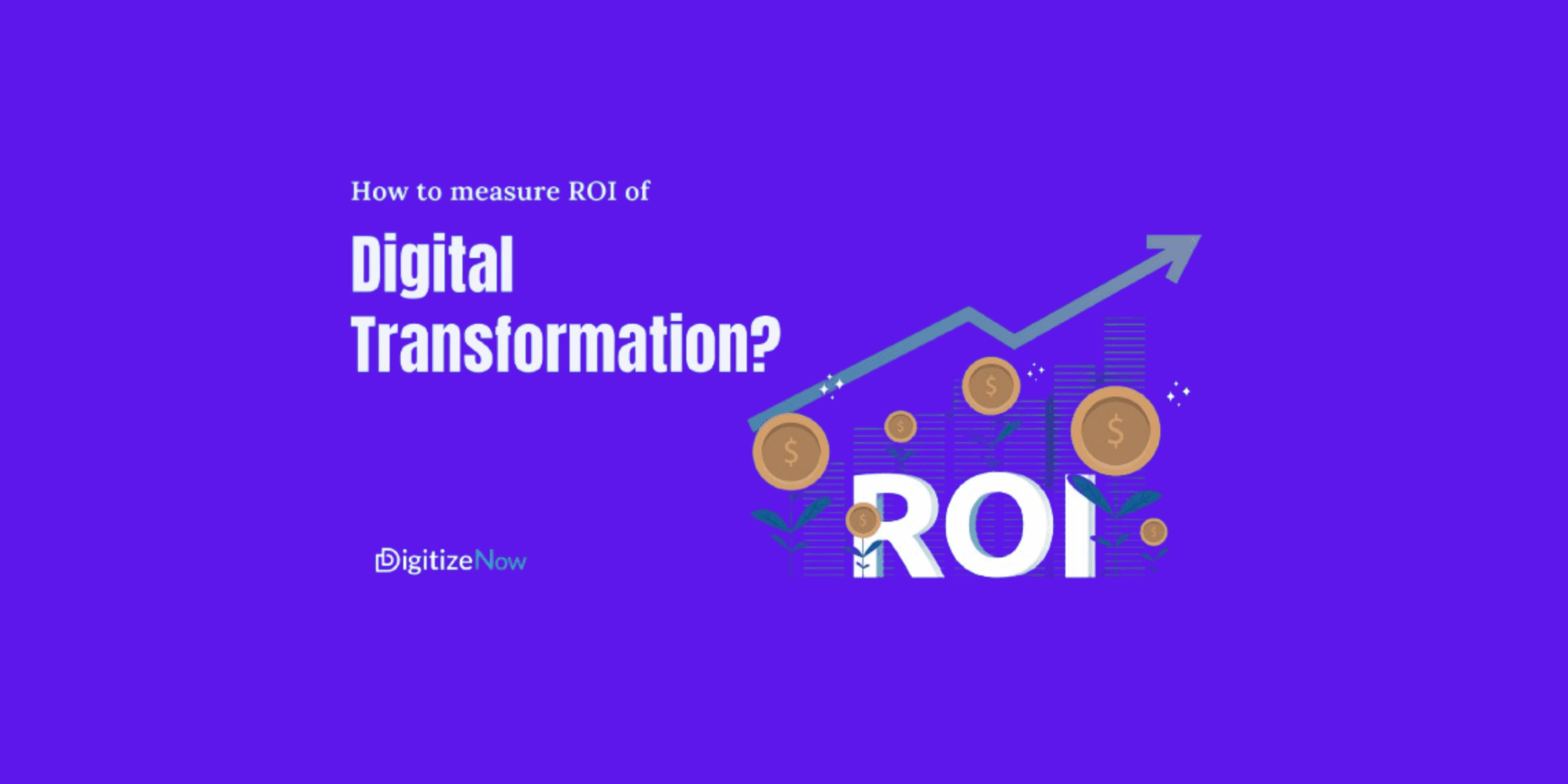

0 Comments